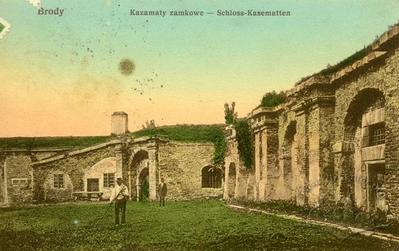
Casemates of the Brody Castle
- ID: 1664
- Place: Brody
- Date: 1910-1914
The postcars shows the Ringplatz (after the Polish “Rynek”) in Chernivtsi, called Piata Unirii in the Romanian times, Red Square in Soviet times and Central Square today. Chernivtsi was made the capital of the Bukowina after the annexation by Austria in 1775 and granted the status of a city in 1786. In those days, the town consisted of around 290 wooden buildings only. It was the so called Springbrunnenplatz in the lower, northern parts of the town which became the first urban center and main square, whereas todays Central Square was still covered with huts and trees. In 1788 stone buildings were exempted from taxes and the first buildings were erected on the later Ringplatz in the 1790s. When Emperor Franz visited Chernivtsi in 1817, the square was already the center of town. In the second half of the 19th c. the houses were replaced by todays three-storey buildings. The town hall sits on the higher southern end of the square wich clearly shows a gradient towards the northern valley of the river Pruth. Only in 1832 Chernivtsi got a regular Magistrat (city council) headed by a proper mayor. In 1843 the contruction work for a city hall on the Ringplatz started and were finished in 1848. The classicist building by the architect Andreas Mikulicz has a tower of 50 meters, used as watchtower by the fire brigade and a clock which once used to strike every full hour. In Austrian times, it was topped with a gilded double headed eagle. The corner building next to the town hall was built in 1901 as Sparkasse (Savings Bank) by the architect Hubert Gessner, a student of Otto Wagner, in Viennese Jugendstil (Secessionist style). Its facade is decorated with a mosaic of Zsolnay majolica tiles showing the Bukowina being welcomed by the other lands of the Habsburg Empire. Today it houses the Art Museum. The house next to it was built in the 1850s and became the Rumänisches Nationalhaus (Romanian People’s House). In the 19th c. it also served as home of the Landespräsident (the Austrian governor), Emperor Franz Joseph stayed here during his visit in 1855. Today it is home to the Mihai Eminescu Romanian Cultural Society. The house shown on the far right side of the postcard was the Hotel Zum Schwarzen Adler (Under the Black Eagle), the best hotel in town during the times of the Austrian rule. Today it is used by a university. The statue of the Pieta in front of the town hall was erected in 1827 and removed 1923. A market like the one shown on the postcard was usually held on Mondays and Fridays. The streetcar (in those days called tramway in Chernivtsi) shown on the postcard is a line number 1 circulating between the Volksgarten raiway station and the river Pruth. It was poduced in 1908 by the Grazer Waggonfabrik. The Central Square is the urban center of Chernivtsi, no less than seven streets meet here. Plans to give the square a modern and more attractive appearance and to solve the critical traffic situation are waiting to be implemented.
Helmut Kusdat